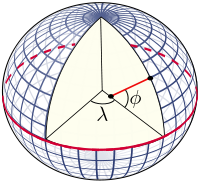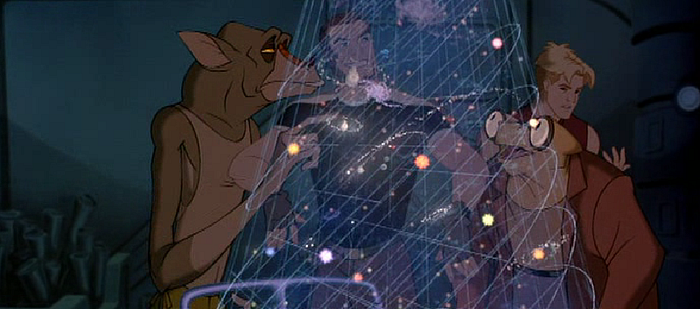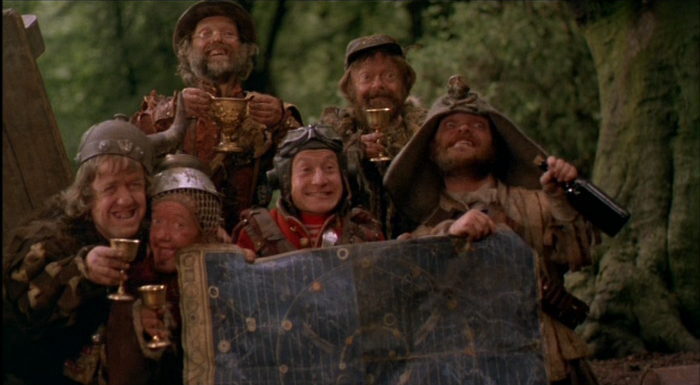Maps in Movies Ranked
I honestly hate nit-pickers. Movies are instruments of emotion designed to make us feel things that we will pay for the privilege of feeling. Sometimes the purpose of a film is to inform. More often it isn’t. While I admire the dedication to the craft some filmmakers apply to research and realism, if the laws of physics are incidentally damaged in the process of making a good story, I’m usually all in. I completely appreciate that this sentiment may not be shared among physicists. Should the reader be interested in what a cartographer notices about maps in movies, I’ve supplied a few notes below.
Prometheus (2012)
We’ll begin with the lowest of hanging fruit: a film that squeezes an impressive amount of face-palmingly stupid decisions into only 124 minutes. This is such well-trod territory that it almost feels unfair to point out a few more. There’s an obligatory sci-fi cliche hologram map scene but the sequence that really got me were two decent scenes that on their own would be respectable film-craft:
- A team of scientists exploring a desolate planet find a giant cave of artificial origin. They go inside to release drone “pups” that make a 3D map of a massive alien structure. Despite the whole point of a remotely operated vehicle allowing the operator to sip coffee at a comfortable distance away while the drones do all the work autonomously, an entire team of scientists drops the drones off in the scary tunnel to absorb any unknown threats personally and bodily. This is perfectly consistent with the rock-bottom quality of science that is done throughout the film and possibly represents some kind of internal story logic that will no doubt be revealed in one of the inevitable sequels about how they were supposed to be all idiots. But the drones. With the exception of hover technology and long battery life and wolf-howling voice recognition, the LiDAR survey drones were pretty much off the shelf technology even a few years before the movie came out. Applying a small explosive charge to the surface and then reading the percussive echoes back like geologists have been doing for decades would give you similar information in about a second (and would involve explosions!) but the payoff wouldn’t be the dramatic “My God look how big this thing is” moment experienced by the crew back on the ship where everyone is crowded around a screen watching the drones make a complete 3D model in real time as they venture deeper and deeper underground. It’s good visual story telling and it makes the audience get this sense of foreboding despite how thoroughly bored Idris Elba looks watching it all happen. Then the geologist reports his subterranean position with a 6 digit string of numbers which is presumably a needlessly complicated labelled grid network which everyone else aboard has instantly memorized. They could have used geocodes like whatthreewords or specified his location in relation to the entrance or some useful landmark but number strings sound pretty sciencey. The ship detects alien life forms deep in the passageways and everyone gets scared but if they can pick up mysterious “life energy” surely they can track their own people in their fully mapped cave model rendering the geo location code irrelevant? Anyway, everything is fine up to here.
- Because the team almost immediately gets lost. We just spent several minutes of run time establishing that we can detect life signs, deploy autonomous mapping drones, identify precise coordinates with 6 digit location codes and not even a piece of yarn tied to the doorknob could keep these idiots from getting lost. This is something that is allowed to happen to Scooby and Shaggy but not mappers. Not scientists with all of the necessary tools. Not while they are still in radio contact with the ship through solid rock.
Getting lost isn’t a bad narrative device but you can’t get lost within ten minutes of having mapped everything. I’d be more offended by the incompetent geospatial/geology expert but since all of the scientists in this movie are terrible I don’t feel like they were picking on mappers in particular. Ridley Scott just hates scientists.
7/10 for each scene. 1/10 for having both in the same movie.
Close Encounters of the Third Kind (1977)
A stream of repeating digits is received by otherwise tight-lipped aliens and no one can figure out what they mean. Except the French scientist’s translator standing in the background used to be a cartographer and he pipes up that the numbers are coordinates. Everyone’s minds are blown. This is one of my favorite scenes in one of my favorite movies but it also has more layers of shit than a seabird colony.
This isn’t like trying to communicate with aliens by feeding them prime numbers, there is no universal constant to mapping conventions. The lat-long system of coordinates on earth was invented by humans in Ancient Greece in the third century BCE and despite the extensive math behind it, is founded on a stack of arbitrary conventions. Latitude would be easy to figure out for an alien- you can do some math and identify an equator from orbit- but how would you record it?

We measure latitude as an angle from the equator in degrees. The poles are 90 degrees from the equator which is 0 degrees. To get more precise, we record 1/60th of a degree as a minute which is called 1 nautical mile. 1/60th of that is a second and it’s about 100 feet at the equator. This allows you to get pretty darn precise. If you want to make it easy on yourself you can just use Decimal Degrees (DD) like Google Maps does which chops up a degree into tenths, hundredths and thousandths rather than Degrees Minutes and Seconds (DMS) because no one has time to multiply stuff by 1/60ths. Anyway, the aliens use DMS. For some reason.
That’s not too bad except that the only reason why we use 360 degrees in a circle is because Babylonian mathematicians liked that it was divisible by 2, 3, 4, 5, 6, and 12 which is handy if you’re a culture obsessed with numerology and the spiritual significance of numbers and their factors. For everyone else in base 10 land (which is a convention mostly because our species got used to counting on our fingers) it’s kind of a pain in the ass. Anyway, degrees are weird and you wouldn’t be able to rely on an alien civilization using feet or meters so using radians would probably work better as a means of interstellar geographic communication because you can specify latitude as a fraction of the circle’s circumference instead of trying to justify all of ancient Mesopotamian religious tradition.
Then there’s longitude which is it’s own kind of complicated. Sir Isaac Newton boldly claimed that figuring out longitude was an unsolvable problem and it basically was until the 19th century. The Equator is a nice geometric landmark, as are the poles, but there isn’t anything to help you determine how far east or west you are on a round planet. You can place a prime meridian anywhere you want to. The French had maps centered on Paris, the US briefly had one in Washington DC and Britain’s lobbying campaign combined with its global empire finally convinced the world in an international agreement that we should all use a common standard where the prime meridian passes through Greenwich England in 1851. The aliens have been studying humans for decades but they’re still not great at communicating with us in any way more sophisticated than with xylophones which leads me to believe that any longitude value would be real tough to trust. If we look over the technician’s shoulders and peek at the printout itself, the longitude starts with a positive number, 104 44 30. Since Wyoming is in the Western Hemisphere, the longitude should be labelled with a “W” or have a negative value to indicate that we’re counting degrees West of the Prime Meridian. At the same latitude, 104 degrees East is in Inner Mongolia in China.
But let’s say the aliens did figure out latitude and longitude and our 360 degree circles. If you convert the alien transmission (104 44 30, 40 36 10) to decimal degrees (40.60278, -104.7417) and type it into Google Maps (which can’t read DMS) it doesn’t get you Devil’s Tower Wyoming (the indigenous name is Bear’s Lodge and is the accepted modern usage, FYI). It gets you Fort Collins Colorado. That’s because the earth isn’t a perfect sphere and there are different mathematical models of the earth called datums and if you use the wrong one, the same coordinates can get you different locations. It’s like if you tried to draw latitude and longitude lines on a cantaloupe and then tried to transfer the markings to a soccer ball- the lumps and irregularities make it hard to come up with a clean, uniform line and the earth is not only locally lumpy but markedly squashed at the poles and a big bulgey at the equator.
Finally, if you have an expensive globe you can find latitude and longitude without having to take it out of its stand. Seriously, that’s a gorgeous globe. Have some respect.
3/10 Abysmal science and disrespect to cool globes overshadow some really great film making.
The Mask of Zorro (1998)
A bunch of people fight over a treasure map to a gold mine. That’s kinda neat. But the real hero of the movie is the map itself:
https://youtu.be/pz0R9XJciO0?t=1m57s
Sure, the map shows Arizona and New Mexico borders which were drawn much later in the century than the story takes place but, rare among maps, this one isn’t just a plot device, it physically comes in handy! It is the most active map I’ve seen since that episode of MacGyver.
4/10 Map gets to physically help advance the plot even if it’s not a great map.
Titan: AE (2000)
I think maps show up in science fiction a lot because writers have to help the audience explore and understand a whole new universe and guide us through new and interesting places that don’t make sense to us yet. Maps are a familiar way to make structure out of unfamiliar chaos. The map in this movie is basically just that: a narrative backbone that helps us get from beginning to middle to end in a predictable way. It is as linear as an episode of Dora the Explorer. But even for space-hologram-cliches it’s kinda neat.

When the protagonist (voiced by Matt Damon in perhaps his most Matt Damony role) puts a ring that his dead dad gave him, a map gets projected on his hand that he uses to guide his unlikely team of rejects on a mission to save humanity. It’s a cool map but it loses points for readability and accessibility because they needed sentient bats to tell them how it works.

5/10 Stylish wearable map. Worn out story line.
Star Wars: The Force Awakens (2016)

The Force Awakens is basically all about finding Luke Skywalker. How do you find anything in a movie? With a map. In this case, a super cool looking map that kind or reminds me of Mapzen’s Tron map. It’s a nice improvement from other holographically generated and plexiglass-displayed maps seen elsewhere in the franchise.
In TFA, the map is flat or at least disc shaped. Maybe this map is just a cylindrical slice of a bigger 3D model of the galaxy? Is that why there’s no depth? I think this map is like a page in an atlas. The galaxy is a big place and you wouldn’t want to show it all at once and fry your server so you access it one small piece at a time. That might explain why there’s that weird irregular chunk of map missing. It’s a page in the atlas that’s missing. And all of the pages are funky, blocky things I guess? The part that really gets me though is that the chunk of the map that’s missing is apparently one that only Luke had. I understand that no one knows where Luke is but Luke’s position could be recorded as a coordinate notation or set of directions. It should simply be a matter of finding his address but in the Star Wars universe there’s this giant chunk of the galaxy that has been surveyed and mapped but apparently missing?
If I’m trying to hide but I want to leave a clue of where I am, I might flee to North Dakota, record my coordinates to leave with someone and then hunker down. I don’t have to erase all maps and knowledge of North Dakota except for one piece that has a treasure-map-style path to my hideout.
Speaking of routes, this map also has MapQuest-like routing options which is nice but it leads the would-be spacefarer on a crazy, wiggly pattern through the galaxy which makes zero sense. Space is big. And it’s made up of mostly empty space. Hence the name. The stars are far enough apart that you don’t really need to alter your course around them that much for most distances and you certainly don’t need to deviate your course this badly to get from one star system to another. It should be a more or less straight shot but then I’m sure some asshole in the comments will have a convoluted explanation about hyperdrives and kessel runs. Whatever. Bring it nerds.
6/10 Pretty GUI. Poor data management.
Casablanca (1942)
Casablanca is a movie that relies upon an understanding of the politics and geography of European refugees in the early 1940s. Some awesome practical effects and simple narration bring the audience up to speed with efficient, beautiful precision. Not bad pre-CGI.
7/10 Classy oldschool map special effects.
Indiana Jones (1981–89)
ALL THREE Indiana Jones movies are map movies. There’s a thing Indy has to find and there’s a map he uses to find it. They’re treasure hunt adventures. Sometimes there’s a paper map, sometimes a notebook with some written directions, sometimes there’s just a staff, a headpiece and a scale model of the ancient lost city of Tannis. This series of THREE movies can satisfy all of your cartographic needs.
Excellent fedora-tip to common map cliches:
“ So forget any ideas you’ve got about lost cities, exotic travel, and digging up the world. We do not follow maps to buried treasure, and “X” never, ever marks the spot.”
Pretty travel sequences.
And even major plot points.
Finding the Well of Souls with a 3D model of the city is one of the coolest maps in fiction. It’s even pretty plausible since the characters point out you need to take into account the date and time of day which wouldn’t be too tall an order for any ancient civilization as stoked about astronomy as the Egyptians were. Presumably Indy’s notebook had a conversion to Ancient Egyptian calendar dates. He’s a professor. I’ll go with him on that.
Then there’s the map in The Last Crusade which is a scholarly work of the senior Dr. Jones who has pieced together the location of the Holy Grail through his archaeological research. When the Jones’ go after the grail and have to choose between getting the lost map or the research papers of the elder Jones, apparently the diary is more important than the map which is kind of a bummer.
8/10 Fun, classic and believable maps that lead to totally unbelievable things.
The map is actually an artifact from the Supreme Being’s creation of the universe. It is a blueprint of existence. You can use it to travel through space and time and steal shit from Napoleon. Finally a map that respects cartographers as having God-like powers. Or God having cartographer-like powers.

It’s also printed on a durable fabric and seeing how often other adventure maps are printed on paper and get torn, this one holds up pretty well.
9/10 Maps with supreme cosmic power!
This is the most accurate depiction of GIS in any media I have encountered. I have uttered these exact phrases innumerable times in my life.
10/10 Exceptional depiction of an actual GIS professional.
The Emperor’s New Groove (2000)
Undeniably the best map from any movie ever made.
11/10 By all accounts, this rating system doesn’t even make sense.
The Great Dictator 1940
The Globe Scene. It is magical. If you haven’t seen it, watch all of it right now. It is as rapturous and beautiful as a ballet while being funny, satirical and unflinchingly critical of the hubris and naked ambition of fascism before it was cool to do so in the “America First” era of United States diplomacy. It’s not just a globe. It’s cultural ammunition in the war against authoritarianism and there’s no plainer symbolism. It’s divine.
It’s easy for me to imagine a modern adaptation of this scene in which Donald Trump tears the United States off of the globe and plays around with it without the rest of the world (and probably dropping it on the floor in the process) and I think that speaks a great deal about the persistence of this visual metaphor. It still works even when many of the other jokes in the movie fall flat or feel dated.
12/10 Elegant. Funny. Right.
